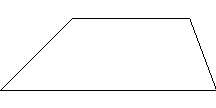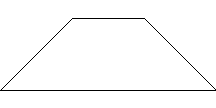|
Mentor: There is one more family of quadrilaterals that we need to talk about. I need to tell you about trapaziods. Trapezoids have exactly one pair of opposite sides that are parallel. Student: Are those opposite sides congruent too? Mentor: They don't have to be. A trapezoid can look like this:
 Student: Oh, so the other sides can look any way that you want them to? Mentor: Right. However, the other sides cannot be parallel because we say that trapezoids have exactly one pair of parallel sides. Student: Yeah, because if it had 2 pairs of parallel sides then it would be a parallelogram! Mentor: That's very perceptive of you! Do you all remember what we called a triangle that had two congruent sides? Student: That's an isosceles triangle. Mentor: Right. So what do you think we call a trapaziod in which the two non-parallel sides are congruent? Student: An isosceles trapezoid? Mentor: Very good! Can you draw one of those? Student: I think it would look like this:
 Student: Yeah, because if it had 2 pairs of parallel sides then it would be a parallelogram! Mentor: That's very perceptive of you! Do you all remember what we called a triangle that had two congruent sides? Student: That's an isosceles triangle. Mentor: Right. So what do you think we call a trapaziod in which the two non-parallel sides are congruent? Student: An isosceles trapezoid? Mentor: Very good! Can you draw one of those? Student: I think it would look like this:
 You know many types of quadrilaterals now!
|
